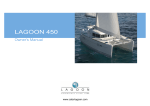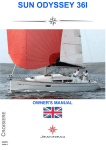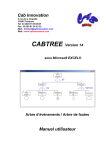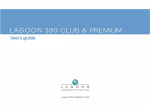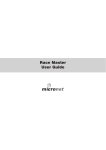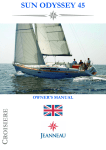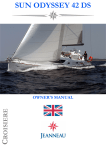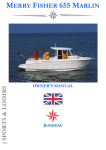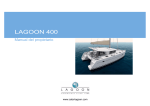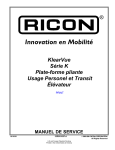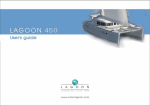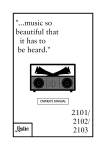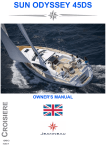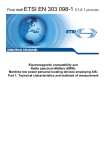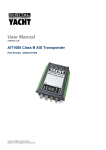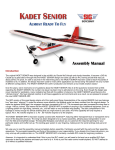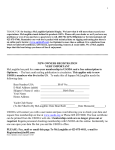Download LAGOON 400 - Lagoon catamarans
Transcript
LAGOON 400 Owner's Manual www.cata-lagoon.com We share a common passion for the sea: we, LAGOON as shipbuilders and you who want to live your passion on the Seven Seas. We are delighted to welcome you to the great family of LAGOON boat owners and we congratulate you on it. This manual was meant to help you to enjoy your boat comfortably and safely. It includes the boat specifications, the equipment provided or installed, the systems and tips on her operation and maintenance. Read this manual carefully before you put out to sea so that you can make the most of her and avoid any damage and any trouble. Get to know your boat before you sail. We keep improving our boats as we want you to benefit from the technological developments, new equipment or materials and our own experience. That is the reason why the specifications and information given are not contractual, they may be modified without prior notice or up dates. This instruction guide has a general purpose and it may mention some equipment or accessories or deal with some points or questions that are not relevant to your own boat ; if in doubt, refer to the inventory that you received on delivery of your boat. Our network of LAGOON authorized dealers will be at your disposal to help you get acquainted with your boat and will be the most qualified to take care of her maintenance. If this is your first boat or if you change to a new type of boat which you are not used to, get some training in boat control and sailing to ensure your safety and comfort. Your dealer, your international sailing association or your yacht club will be very happy to recommend local sailing schools or professional instructors. Even if everything has been provided for and designed for the safety of the boat and the safety of her users, don't forget that sailing highly depends on the weather conditions, the sea condition, and that only an experienced and very fit crew, handling a well-maintained boat can sail satisfactorily. The sea and wind conditions that correspond to the design categories A,B or C are changeable and are dependent on the hazards of unusually strong waves or gusty winds. Therefore total safety cannot be guaranteed, even if your boat meets the requirements of a category. Always listen to the weather forecast before you put out to sea. Make sure the sea and wind conditions will correspond to the category of your boat and you and your crew are able to handle the boat in these conditions. The sea and the water are not the natural environment of Man and one has to respect their laws and strength. Adapt the use of your boat to her condition that wears out with time and use. Any boat, however solid she may be, may be severely damaged if badly used. This is not compatible with a secure navigation. Always adapt the speed and direction of your boat to the conditions of the sea. The 'COLREG', an international regulation in order to prevent collision at sea, published by the International Maritime Organization, specifies the steering and course regulations, the navigation lights etc. throughout the world Make sure you know these regulations and you have on board a manual that explains them. In numerous countries, a licence, an authorization or a training course is requested. Make sure you have this legal authorization before you use your boat. Always use an experienced technician for the maintenance of your boat, the fitting of accessories and the carrying out of small modifications. The written authorization of the builder or his legal representative is compulsory for modifications that alter the specifications of the boat, in particular the vertical layout of the grounds (putting up of a radar, modification of the mast, change of the engine etc.). For the essential or optional equipment (engine, electronics etc.) refer to their respective manual delivered with your boat. The users of the boat are informed of the following: - The entire crew must be trained properly. - The boat shall not be loaded more with than the maximum load recommended by the builder, in particular the total weight of the food supplies, of the different equipment that are not supplied by the builder and of the persons on board. The weight of the boat shall be properly distributed. - The water in the bilge shall be kept at its minimum. - The stability is reduced when you add weight in the upper parts. - In case of heavy weather, the hatches, lockers and doors shall be closed in order to minimize the risk of water coming in. - The stability may be reduced when you tow a boat or when you lift heavy weights with the davits or the boom. - Breakers are serious dangers to stability. - In the boat there shall be all the proper safety equipment (harness, flares, liferaft etc.) depending on the type of boat, the country, the weather - The crew must be familiar with the use of all the safety equipment and the emergency safety procedures (MOB, towing etc.). - Anyone on the deck shall wear a life jacket or a buoyancy aid. Please note that in some countries it is compulsory to wear an homologated buoyancy aid permanently. Keep this manual in a safe place and hand it over to the new owner if you sell your boat. CONTENTS Chapter Page Using your boat 1 2 3 Navigation................................................................................................................................ 5 Winter Storage....................................................................................................................... 23 Launching .............................................................................................................................. 27 Construction and equipment 4 5 6 7 8 9 10 11 Hull & Deck ............................................................................................................................ 35 Interior.................................................................................................................................... 43 Electricity ............................................................................................................................... 53 Plumbing................................................................................................................................ 65 Engine .................................................................................................................................... 77 Rigging and Sails .................................................................................................................. 87 Safety ..................................................................................................................................... 99 General specifications........................................................................................................ 111 Personal notes UPDATE 10/20 10 - INDEX C 3 1 Navigation GETTING UNDER WAY ................................................. 7 VISIBILITY IN NAVIGATION .......................................... 7 NAVIGATION UNDER MOTOR ....................................... 9 NAVIGATION UNDER SAIL ......................................... 11 MOORING ................................................................... 17 TOWING ...................................................................... 17 ANCHORING ............................................................... 17 DAVIT (OPTIONAL) ..................................................... 21 ENVIRONMENT ........................................................... 21 5 GETTING UNDER WAY STARBOARD CABIN FOOTBOARD PORT CABIN FOOTBOARD NAVIGATION 6 1. Battery switch "common negative" 2. Battery breaker - "positive terminal - engine" - To port 3. Battery switch "service positive" 4. Battery switch of negative terminal - Starboard engine 5. Battery breaker - "positive terminal - engine" - To starboard 6. Battery switch - Coupling SLIDING HATCH 1 - Saloon. 2 - Saloon. 3 - Galley. 4 - Cockpit. SWITCH ENTRANCE LAGOON 400 FUEL SUPPLY VALVE (located directly on the tanks) NAVIGATION Getting under way The sliding door locks in three different positions: closed, ajar (airing position) and open. A latch on the doorframe enables locking from inside the saloon. RECOMMENDATION While sailing block the sliding door shut. Check the charge rate of the batteries, the water level in the tanks and the fuel level (see ELECTRICITY and MOTORIZATION chapter). Carry out the inventory of compulsory safety equipment and instruct the crew concerning its location and operation. DANGER Remember to disconnect the shore power supply before casting off. RECOMMENDATION When entering the saloon be careful of the step leading down into the port hull. Switch on the main power of the boat by activating the battery switches located in the port and starboard aft cabins,then activate the different accessory switches on the electrical panel. V i s i b i l i t y i n n a v ig a t i o n The international regulations to prevent collision at sea (COLREG) and the course regulations make mandatory a permanent and proper surveillance and the respect of priority. Make sure there is no other boat on your way. The visibility from the steering station may be obstructed in the following conditions: - Load and load distribution. - Sea conditions, rain, spray, fog or darkness. - Lights on inside the boat. - Persons and removable equipments in the helmsman's field of visibility. LAGOON 400 1 NAVIGATION 7 NAVIGATION 8 LAGOON 400 NAVIGATION N a v i g a t io n u n d e r m o to r Before starting the engine: - Ensure that the fuel valves are open. - Open the valves for the engine cooling systems. (See "Motorisation" chapter). To start the engines, refer to the manufacturer's manual too. • ENGINE STARTER Turn on the battery switches located in the port and starboard aft cabins. - Disengage the reverse gear (it will make the acceleration possible when in neutral). Proceed in the following order: - Start the port engine first. - Then start the starboard engine. After starting the engine check for cooling water running out of the exhaust and observe the color of exhaust gases. • BATTERY COUPLING In the case of low engine battery power use the battery coupling function by turning on the coupling handle located in the starboard aft cabin. Once the engines have been restarted make sure that the coupling handle is turned back to its original position. LAGOON 400 • NAVIGATION When the engine is running, avoid making noise and chops near the other users. Respect speed limits. WARNING Never switch off or de-energize the electric system when the engine is running. 1 NAVIGATION 9 RIGHTING MOMENT Illustration showing the difference between the righting moments of a single-hull vesseland a catamaran of 10m length. NAVIGATION 10 CATAMARAN Weight of vessel: 10 tons d: distance between centre of buoyancy and centre of gravity SINGLE-HULL Weight of vessel: 10 tons RMmax: Weight of vessel x d (RMmax: Righting moment Maximum) RMmax Single-hull: 10 tons x 0,5 metres : 5 tons.metres RMmax Catamaran: 10 tons x 3 metres : 30 tons.metres Righting moment: 31.7Tm LAGOON 400 NAVIGATION N a v i g a t io n u n d e r s a i l • BEWARE A catamaran presents 6 times greater heel resistance than a single-hull vessel. In terms of ship design we speak of righting moment (multiplication of the vessel's weight by the transverse distance between the centre of gravity and the centre of flotation (or buoyancy)). See illustration on previous page. This fact has real consequences for the handling and sail-trimming of a catamaran. The fact that the boat will not heel over could conceal an excessive sail surface area in use, which could be dangerous for the crew and the vessel. It is therefore essential to constantly monitor the real wind speed and to trim the sail surface area as a priority in accordance with this speed. These latter adjustments are valid in calm seas. In rough seas one should take the precaution of reducing 10% earlier in terms of real wind speed. Generally speaking, it is essential to constantly look to relieve the vessel rather than to put it under stress. One should always look for the sail angle of attack to be headed to the apparent wind and the sails to be not over-trimmed so that the airflows leaving the sail are parallel to each other, that is to say they do not create turbulence behind the sail. Failure to follow the above recommendations can be dangerous for the boat and the crew, and the manufacturer cannot be held responsible in the event of an accident. LAGOON 400 • CLOSE HAULED TRIMMING (between 75 and 50° to true wind) Given wind force in apparent wind - From 0 to 16 knots: full sail ; mainsail traveler 30 cm to windward of center, mainsail trimmed with a slightly opened leech (boom centered). The Genoa jib is trimmed near the spreader,the Genoa traveler is placed so that the angle of the Genoa sheet forms a straight line with the clew and the luff, at 40% of its height. - From 16 to 20 knots: full sail ; the mainsail traveler moves up to 60 cm to windward of center, mainsail trimmed with a slightly more open leech (boom still in line: so the sheet will have to be slackened). The Genoa traveler does not change position but adjust the sheet so that the leech is 10 cm from the spreader. - From 20 to 26 knots: 1 Reef, full Genoa ; the mainsail traveler comes back to 30 cm to windward of center. The Genoa traveler does not change position but adjust the sheet so that the leech is 20 cm from the spreader. - From 26 to 30 knots: 1 Reef, 75% of the Genoa ; the mainsail traveler comes back to 60 cm to windward of center. The Genoa traveler remains in place or moves slightly forward but it is adjusted so that the leech forms a propeller, the upper part dumping air out under strong gusts of wind. - From 30 to 36 knots: 2 Reef, 60% of the Genoa ; the mainsail traveler returns to the 30 cm to windward of center, the boom is slackened to fly 50 cm leeward. The Genoa traveler is moved slightly forward, the adjustment remains the same. 1 NAVIGATION 11 SAILS SAILS SURFACE Classical mainsail: 56 m². 1 Reef: 45 m². 2 Reef: 32.48 m². 3 Reef: 20.20 m². NAVIGATION 12 Large gaff sail: 60.5 m². 1 Reef: 45 m². 2 Reef: 32.48 m². 3 Reef: 20.20 m². Furling genoa: 28 m². Reference 1: Reference 2: LAGOON 400 21 m². 16 m². NAVIGATION - From 36 to 45 knots: 2 Reef, 40% of the Genoa. The mainsail traveler is dead center and the boom veers 1 meter to leeward. The Genoa traveler moves forward slightly, the sheet is slackened to open wide in strong wind conditions. - From 45 to 55 knots: 3 Reefs alone (either storm sail or lie to), traveler in the center,mainsail out by 1 meter. The boat will be more at ease scudding in this weather. - Over 55 knots: lie to, drag anchor or, preferably, scud bare poles. • CLOSED REACHED TRIMMING (between 75 and 130° to true wind) - From 0 to 23 knots: full sail ; the traveler is positioned between 1 meter from centre up to windward of center, depending on the wind angle, the sheet is slackened so that boom is veering out anything from 50 cm in calm weather to 2 meters when the wind is forcing. In every case no more than one batten should be allowed to chafe at the shroud at the fastest speeds. The Genoa jib is slackened so that its average attack angle is head on to the apparent wind. - From 23 to 28 knots: 1 Reef, full Genoa. The adjustments are identical. - From 28 to 33 knots: 2 Reef, 80% of the Genoa. The adjustments are identical. - From 33 to 38 knots: 2 Reef, 60% of the Genoa. The adjustments are identical. - From 38 to 45 knots: 3 Reef (or mainsail lowered and a little more Genoa), 40% of the Genoa. The adjustments are identical. - From 45 to 55 knots: mainsail lowered, 40 to 30% of the Genoa, sufficiently trimmed so as not to flap. - Over 55 knots: scudding,depending on the sea conditions the mooring lines can be looped round behind the vessel and attached on the opposite side to act as a brake. These indications are given for your information only and are dependant on outside conditions. WARNING Your boat is designed to sail without the need to climb onto the roof for any maneuvers. It is dangerous to climb or stay on the roof particularly in the event of gibing. Keep children under close supervision. RECOMMENDATION Under sail put all engine controls in neutral to avoid any damage to engines (with fixed or folding propellers). DANGER Any different setting of these recommendations may result in breakage of the mast. In particular, the 100% genoa with 2 reef in the mainsail is prohibited absolutely. LAGOON 400 1 NAVIGATION 13 NAVIGATION 14 LAGOON 400 NAVIGATION • REDUCING SAIL The boat is fitted with 3 reefs. Reefs n°1 and n°2 are automatic, n°3 is traditional. The luff eyelet of reef n°3 is fitted with a strap with a snap shackle to clip on to the eye bolt on the boom. Refer to the running rigging diagram (chapter on RIGGING AND SAILS) for identification of ropes. RECOMMENDATION For safety, the reef line used should always stay on the winch with 3 turns around the drum. Re-close the cam cleat for greater safety. Putting in reefs n°1 and n°2: 1 - Head the boat into the wind. 2 - Pull tight the topping lift. 3 - Slacken the mainsail sheet. 4 - Slacken the mainsail halyard and then trim reef line n°1 or n°2, as needed, until the reefing blocks which correspond to the luff and the mainsail leech are a few centimeters from the boom. 5 - Close the line cam cleat of the respective reef. 6 - Hoist taut the mainsail halyard. 7 - Slacken the topping lift and take in the mainsail sheet. Follow the lowering and raising of the sail with the help of the head downhaul. Putting in reef n°3: Repeat steps 1 to 3 as before, then: 4- Slacken the mainsail halyard then trim reef line n°3 until the mainsail leech block is a few centimeters away from the boom. - Clip the snap shackle on the luff eyelet of reef n°3 onto the eye bolt located on the boom. - Take up the slack in the lines of reefs n°1 and 2. - Repeat steps 5 to 7 as before. LAGOON 400 • NAVIGATION WIND ASTERN - Do not fall off more than 150° to the apparent wind. - Put the traveler out as far as possible and slacken the sheet slightly. - Make sure the mainsail does not touch the shrouds ; the rubbing of the battens will wear the material and cable very rapidly. - Keep mainsail + solent up to 15 knots speed and put in one reef or more if the accelerations are sudden and strong or if sea conditions deteriorate. 1 NAVIGATION 15 DECK LAYOUT NAVIGATION 16 1 - Midship cleat for towing. 3 - Swimming ladder. 2 - Mooring cleats (Jack-lines to be fixed to the mooring cleats). 4 - Crown buoy location . LAGOON 400 NAVIGATION M o o r in g A sufficient number of mooring lines suitably sized and suitable for the environment shall be on board for mooring your boat. - Always manoeuvre your boat using the engine. - Make allowance for the current and wind when you handle your boat. - Protect your boat to the highest degree with suitably sized fenders. - Always keep the mooring ropes unfouled and stored away. - Handle your boat at a reduced speed. TOWED BOAT - Keep steering your boat and see to it that you stay in the wake of the towing boat. Anchoring As a rule, set the anchor in at least 3 times the depth of water. RECOMMENDATION Before anchoring check the depth of water, the power of the current and the nature of the sea bed. DANGER Don't try to stop the boat with your foot, your hand or a boat hook. AFTER MOORING - Protect the mooring lines against chafing with plastic sleeves. - Make allowance for the variations in tides if need be. • - Install the bridle by fixing it to the chain plates located at the ends of the fore beam. - Put the bridle through the stem bow roller. - Shackle the bridle to the central cleat during the lowering of the chain. • Towing TOWING BOAT - Tow another boat at a reduced speed and as smoothly as you can. - Pay particular attention when you throw or catch the towing rope (it may foul on the propeller). NOTE: The stability may be reduced when you tow a boat. LAGOON 400 PREPARATION OF ANCHORING (Illustrations following page) MANUAL ANCHORING - Have your boat pointed into the wind and without speed. - Release the brake on the chain lifter. - Pay out the chain while moving back slowly. - Secure the anchor chain on the bridle. - Lead out the chain until the guy becomes taut. 1 NAVIGATION 17 ANCHORING NAVIGATION 18 ATTACH THE BRIDLE TO THE FORWARD BEAM BRIDLE OPERATION RELAY WINDLASS 12V 1000W Lay out of: Cockpit bench seat Chain lifter 10mm diameter REMOTE CONTROL WINDLASS CIRCUIT BREAKER 100A Port aft cabin LAGOON 400 NAVIGATION • MOORING WITH ELECTRIC WINDLASS WARNING WARNING Windlass operations are dangerous: Nobody should be aboard the tender during maneuvers carried out with the davits. - Always keep the anchor line unfouled and free. - Always proceed with care, using gloves and always wearing shoes. Activate the windlass with the control found in the windlass locker or from the steering station. If the port engine is not functioning,the windlass can work on service batteries (if available) by switching on the port engine ignition only (the engine alarm will then sound while the windlass is in use). In the case of electrical failure use the winch handle on the windlass to lift anchor. NOTE: The batteries can be recharged via the generator (optional extra) if the engines do not start. After each trip rinse the windlass and mooring line with fresh water. • MAINTENANCE Refer to the manufacturer's instructions for windlass maintenance at the beginning or end of the season. • HEAVING UP THE ANCHOR - Lock the cable lifter snubber. - Ensure the chain is properly set on the cable lifter. - Slowly go near the anchor, using your engine (Don't use your windlass to winch the boat). - Release the bridle from the chain. - Heave the anchor completely. - Visually check the last meters till the anchor gets into contact with the davit. - Secure the anchor or anchor chain to the cleat. LAGOON 400 1 NAVIGATION 19 DAVIT NAVIGATION 20 LAY OUT OF DAVIT WINCH DAVIT BLOCKERS 100A BREAKER (ELECTRIC WINCH DAVIT - OPTIONAL EQUIPMENT:) Lay out of: Port aft cabin LAGOON 400 NAVIGATION D a v i t ( o p t io n a l) WARNING Nobody should be aboard the tender during maneuvers carried out with the davits. Tie up the tender out of the way during maneuvers. • INSTALLING A TENDER ONTO THE DAVITS - Fix the davit line hooks to the forward and aft of the tender. - Close the blockers found on the davits. - Pull the bow of the tender up to halfway using the cockpit winch. - Repeat the operation for the stern. - Alternatively raise bow and stern until the tender comes into contact with the davits. WARNING When under sail remove the tender engine and store it on board the boat. Secure the tender according to sea conditions. WARNING The davits are designed to support a maximum load of 200 kg and a tender of 3,40 meters in length at maximum. Environment LAUNCHING A TENDER FROM THE DAVITS - Ensure that the blockers on the davits are closed. - Thread the davit rope attached to the stern of the tender around the winch (minimum of 3 turns). - Open the blocker and let the line feed out until halfway. - Close the blocker. - Repeat the procedure for the bow. - Alternatively lower stern and bow until the tender comes into contact with the water. LAGOON 400 NAVIGATION 21 RECOMMENDATION We share a love for the ocean. Help us to preserve them ! • 1 Do not discharge oil into the sea. Take every precaution to prevent hydro-fuel overflow when filling the engine tank. When in port,only use the onboard toilets if they are equipped with organic waste reservoirs. The use of detergents is implicated in the destruction of marine plantand animal life. Choose fully biodegradable cleaning products. Do not throw plastic bags and bin bags into the sea. Use the bins provided for this purpose at ports. 2 Winter Storage LAYING UP ................................................................. 25 PROTECTION AND MAINTENANCE ............................ 25 23 BLOCKING THE BOAT ASHORE WINTER STORAGE 24 Positioning planks: longitudinally in bowling. - Minimum length: 2.50 m. - Minimum width: 0.30 m. - Between hull: 4.85 m. Positioning candles: under each bow. LAGOON 400 WINTER STORAGE Laying up - Take ashore all the ship's documents, any lines that are not used for mooring, galley equipment, supplies, clothes, safety equipment, batteries and gas bottles. - Mark again the safety equipment, check the expiration dates, have the liferaft overhauled. - Take advantage of this laying up to draw up a complete inventory of the equipment. • BLOCKING THE BOAT ASHORE Preparation for each hull: - A large rectangular wooden block of 1 m in length and a tire to be placed under the stern, across the keel. - A steel jack-stand of a minimum of 1 m in height which will be placed under the forward part of the forward bulkhead. Make sure that the aft part of the keel is well-chocked (on its block) before very carefully lowering the forward section onto the jackstand. - Retract the sounder and speedometer sensors. - Seal air inlets as much as you can. - Install an atmosphere dehumidifier in the saloon and leave the cabin and storage unit doors open (lockers, ice boxes). - Leave the cushions outside for long before putting them back into the boat in the upright and side position in order to have minimum contact surfaces. • - Thoroughly rinse the hull and deck. - Lubricate all the mechanical and mobile parts with vaseline (bolts, hinges, locks etc.). - Protect all ropes and mooring lines against chafing. - Protect the boat to the highest degree with fenders. - Make sure the boat is properly moored. All these recommendations do not make up an exhaustive list. Your dealer will give you the advice you need and will carry out the technical maintenance of your boat. • P r o t e c t i o n a n d m a i n te n a n c e • INSIDE - Drain all the fresh water pipes and rinse them with water and vinegar (do not use a chlorine based product). - Lubricate and close all the water inlet valves and thru-hull fittings. Rinse and completely drain the heads bowls and pumps. LAGOON 400 OUTSIDE ENGINES RECOMMENDATION Winter storage of the engines is the domain of professionals. Depending on the boat location, afloat or ashore, winterization is different. 2 WINTER STORAGE 25 3 Launching RECOMMENDATIONS ................................................. 29 STEPPING THE MAST ................................................. 31 27 POSITION OF HOISTING CRADLE AND STRAPS 700 7350 5450 1900 450 LAUNCHING 28 A B A: Engine partition B: bulkhead Mast LAGOON 400 LAUNCHING Recommendations A lot of skill and care is required to commission your LAGOON boat. The proper working of all your boat equipments in the future results from the quality of the commissioning operations. The initial launching and the first tests of the different equipments shall be carried out by your LAGOON dealer or agent so you can expect to enjoy the warranty in case of some equipment failure. RECOMMENDATION All future maintenance should be carried out with the greatest care by professionals. If the LAGOON boatyard is not involved in maintenance operations, your guarantee will not cover any incidents linked to handling errors. LAGOON 400 • BEFORE LAUNCHING - If your boat is to be fitted with sounder and speedometer, allow for the relevant fittings and their installation. - Check the water intake strain box for cleanliness. - Check the engine and reduction gear oil levels (refer to engine manual). - All the optional accessories shall be sealed with paste. - Retract the speedometer into its housing (it may be damaged by the handling belts). - Turn off all the water inlet and drain valves (sink, washbasin, heads, engine). • HOISTING Install a fore rope, a rear rope and fenders. Prepare: - 2 Straps (minimum 11 meters). - 4 slings (see diagram opposite). - Attach the 4 slings to the belts. 3 LAUNCHING 29 PACKING FURTHER INFORMATION RELATIVE TO THAT GIVEN IN THE GENERAL SPECIFICATIONS CHAPTER 4083 4395 1735 LAUNCHING 30 11959 4850 7248 1048 The measures are expressed in mm. LAGOON 400 3346 LAUNCHING - Put it slightly under tension ; the sling hooks should be situated at the boat's centre of gravity,either in the longitudinal centre or plumb with the shroud chain-plates in the transverse plane. Hoist gently,and control the movement of the boat with dock lines. DANGER Do not stay on board or under the boat during hoisting. RECOMMENDATION Never place belts or fenders in contact with the large glass windows in the hulls. • AFTER LAUNCHING - Check the sounder and speedometer fittings for tightness if need be. - Open the valves and make sure that they are tight with the hull and relevant hose. Before starting the engine, refer to the MOTORIZATION chapter. LAGOON 400 Stepping the mast If later you have to step the mast anywhere other than at your LAGOON dealer: • BEFORE MAST INSTALLATION - Protect the mast against possible chafing by the crane hook andcable. - Tie down the shrouds and all the riggings to the base of the mast with a lashing long enough to guide the mast heel when stepping the mast. - Protect the spreader end fittings and the roller furler drum. - Put a rope of about 1,50 with an eye and thimble at both ends and covered with rags round the mast. Place the rope under the second tier of spreaders. - Link together both thimbles (that are ahead of the mast) with a shackle large enough to receive the crane hook. - Raise the whole till it is taut under the spreader bases. • DURING MAST INSTALLATION - Take the necessary steps to avoid damaging the mast head equipments. - Use the backstay and lashing at the base of the mast to control the handling. - Engage the electrical harness in the mast base. - Make sure the base of the mast integrally bears on its base plate. 3 LAUNCHING 31 LAUNCHING 32 MAST JUNCTION BOX Lay out of: Compartment - Forward LAGOON 400 LAUNCHING • AFTER MAST INSTALLATION - Lubricate all the bottle screws (see recommendations in the RIGGING chapter)). - Stretch tightly the rigging (refer to RIGGING chapter for settings). - Reconnect the electrical cables in the junction box at the base of the mast located in the forward cockpit locker after running the cables through the gooseneck located at the front of the mast (see ELECTRICITY chapter). - Carefully check the tightness of the turnbuckle cotter pins,and protect with adhesive tape. - Put the boom back. Refit all ropes. RECOMMENDATION Adjust the mast after a few trips. • UNSTEPPING THE MAST Proceed by carrying out the operations recommended for stepping the mast in reverse order,taking care to mark the line locations with stickers. RECOMMENDATION Before all dismasting operation, remember to disconnect the electric cables Pull gently while guiding the cables. LAGOON 400 3 LAUNCHING 33 4 Hull & Deck CONSTRUCTION ......................................................... 37 MAINTENANCE ........................................................... 37 CARREENING ............................................................. 37 GEL-COAT REPAIR ..................................................... 39 STEERING GEAR ........................................................ 39 PUMP FOR DECK WASHING (OPTIONAL) ................... 41 35 CARREENING HULL & DECK 36 Wetted area (including appendices): 46.2 m² LAGOON 400 HULL & DECK Construction The LAGOON 400 is built of balsawood sandwich (monolithic below the water line),polyester resin and vinyl-ester; the counter-mould sare monolithic and the partitions are made of laminated plywood. The nacelle and deck are of balsawood sandwich composite. Maintenance The materials and equipments of your boat have been selected because of their high quality and performance and ease of maintenance. However you shall carry out a minimum maintenance in order to protect your boat from outside attacks (salt, sun, electrolysis ...). Preferably wash your boat on shore. Use as few cleaning agents as possible. Don't use solvents or aggressive detergent agents. Don't discharge your cleaning product into the water. Regularly brush the deck with a degreasing shampoo and fresh water. RECOMMENDATION We strongly advise you against using a pressure washer. You shall not use hot water or steam. LAGOON 400 DECK FITTING - Rinse thoroughly all your equipments with fresh water. - Periodically lubricate blocks, sheaves, bottle screws, winches, rails and travellers with a water-repellent grease. - Stainless steel that is showing small spots or blisters of rust should be cleaned and polished with a chrome and steel renovator. SOLID WOOD ON EXTERIOR WOODEN PANELLING Regularly clean the woodworks with fresh water using a sponge (if need be add some gentle soap). PLEXIGLAS - Rinse plexiglas with fresh water. - Brighten up with a soft rag soaked with liquid paraffin. - Use polish paste to remove scratches. C a rr e e n in g A (tin-free) anti-fouling painting every year will make it possible to avoid tedious and frequent careening. An epoxy coat is recommended beforehand. We recall that any excessive sanding before antifouling is an attack for your gel-coat and replaces it by its fiablité sealing. Your boat may regain her shine as new if polished. If a lasting and isolated problem arises, contact your dealer. 4 HULL & DECK 37 STEERING GEAR 1 - Steering rack. 2 - Ropes 3 - Sheaves box. 4 - Connecting rod. HULL & DECK 5 - Autopilot ram (optional). 38 CABLE TENSION SYSTEM LAGOON 400 HULL & DECK G e l -c o a t r e p a ir Keep the components 6 months maximum. Polyester products are flammable ; take the usual precautions. MIXING RATIO Our products contain an accelerator, you just have to add the catalyst (a colourless liquid). The usual ratio is 2 %. The gel setting time (working time) is about 1/2 h, curing takes about 10 h. WARNING Please respect the following conditions to repair successfully: - Dry weather. - Temperature between 15° C and 25° C. APPLICATION - To fill up a blister hole or a scratch, sand and clean the area with acetone. - Prepare the necessary amount of gel coat, preferably on a glass plate. - Apply the product with a spatula or a point and the layer shall be thick enough to make possible a further sanding. - In order to blend minor touching up on smooth surfaces, stick sellotape (or even better, a mylar tape) on the freshly applied gel coat. - Remove sellotape after curing. - To get a highly shiny finish, sand with extra fine abrasive and water then polish. STORAGE To keep them properly, store the gel coat components in a cool dry and dark place. LAGOON 400 CLEANING YOUR TOOLS Clean all your tools with acetone. DANGER The catalyst is a dangerous product: - Keep it out of the reach of children. - Avoid contact with skin and mucous membranes. - In case of contact wash with soapy water and rinse thoroughly. S t e e ri n g G e a r The steering system is accessed via the engine compartment. - Regularly check its tension. - Don't tighten the steering cables excessively. - Lubricate all the elements. Maintain the nylon, ertalon or teflon bushes only with WD40. Proper settings result in gentle steering resistance,without hard points and without looseness. 4 HULL & DECK 39 PUMP FOR DECK WASHING Connection (Reference 1) HULL & DECK 40 Seawater inlet (Reference 4) Selection valve Fresh water / Sea water (Reference 2) Switch (Reference 5) Pump for deck washing - 12V (Reference 3) LAGOON 400 HULL & DECK P u m p fo r d e c k w a s h i n g (o p t i o n a l ) It provides sea water or fresh water from the reservoir. A switch is located next to the electrical panel for its initiation. It is on 12 V supply as soon as the boat's power is turned on (Service battery switch). 4 HULL & DECK 41 LAGOON 400 5 Interior INTERIOR MAINTENANCE .......................................... 45 FABRICS ..................................................................... 45 PORTHOLES AND DECK HATCHES ............................ 47 WASHING MACHINE (OPTIONS) ................................. 49 HEATING (OPTIONAL) ................................................ 49 AIR CONDITIONING (OPTIONAL) ................................ 51 43 INTERIOR INTERIOR 44 3 cabin version. LAGOON 400 4 cabin version INTERIOR Interior maintenance - Take advantage of the fine weather to take the settee and berth cushions out. - Put the cushions vertically if you leave the boat for long. - Use blinds to protect the inside of the boat against UV rays. - Make sure the bilges are clean and dry. • INSIDE VARNISH - Rinse the inside varnish with fresh water mixed with spot remover and shampoo. - Polish the inside varnish with shammy leather. - Rub with a clean and dry rag. - Brush the fabric against the grain. - Use the vacuum cleaner when the fabric is dry. PVC OR COATED FABRICS - Use a sponge and water and soap (household soap type). - Dab away resistant stains with a rag soaked with white spirit, do not rub them. RECOMMENDATION For the PVC fabrics, don't use any solvent or solvent based product (pure alcohol, acetone, trichloroethylene). INTERIOR RECOMMENDATION Use as few cleaning agents as possible. Don't discharge your cleaning product into the water. Fabrics 100% POLYESTER/DRALON JACQUARD If you cannot remove the fabric: - Clean with the vacuum cleaner. - Clean with synthetic foam (please refer to the product instructions). ADVICE: Mark up each cover and foam when dismantling. If you can remove the fabric: • - Hand wash with an ordinary washing powder at 30° C. STAIN REMOVAL - Remove as much stain as you can with a knife blade (from the edge towards the centre). - Dab with a clean rag. - Remove the stain with solvent on a clean rag. Never pour the solvent directly over the stain. LAGOON 400 5 In both cases, dry cleaning is possible. Remove the stains as soon as possible with a damp rag. 45 COCKPIT TABLE - DECK HATCH INTERIOR 46 LAGOON 400 STOWING COCKPIT TABLE LOCKING DECK HATCH Cupboard - Starboard pasageway (Left-hand handle button in open position.) (Right-hand handle button in closed position.) INTERIOR AMARETTA - Wash in warm water with a neutral pH soap. - Dry it naturally. LEATHER - Use a leather cream for ordinary care. - Do not use detergent. - Do not use silicone based products. - Clean with a sponge and soapy water. - Remove ball point pen marks with methylated spirit. - Remove the grease stains with an absorbent powder (e.g. talcum powder). P o rt h o l e s a n d d e c k h a t c h e s The portholes and deck hatches are equipped with latch systems to keep them in a closed position. At mooring,intermediate opening positions allow for airing of the boat. 5 INTERIOR 47 LAGOON 400 WASHING MACHINE - HEATING WASHING MACHINE (110V - 220V) HEATING INTERIOR 48 Lay out of: Starboard pasageway 1. 220V socket 2. Valve - House water inlet 3. Draining valve Outlet Hot air Diesel pump Breaker Lay out of: Port aft cabin Starting and temperature control The positions are the same for the other layout version. LAGOON 400 INTERIOR Washing machine (Options) - Make sure that there is sufficient fresh water before using the washing. - Open the water supply and drain valves. - Connect the shore power supply or start the generator (see ELECTRICITY chapter). - Switch on the circuit breakers in the port aft cabin cupboard. - Switch on the relevant machine. For use and maintenance of the material consult the manufacturer instructions. H e a t in g ( o p ti o n a l ) The heating system works on 12 V. It consists of two 4000 W heaters located under the forward saloon bench seat and in the starboard aft cockpit locker. The heaters are supplied with diesel from the starboard tank. To operate the system: - It is on 12 V supply as soon as the boat's power is turned on (Service battery switch). - Switch on the heaters with their controls located in the starboard aft cabin and in the saloon at the steering station. - Adjust to the required temperature. For use and maintenance of the material consult the manufacturer instructions. LAGOON 400 5 INTERIOR 49 AIR CONDITIONING Compressors - Lay out of POWER: 44000 BTU - VERSION 3 CABIN. : 48000 BTU - VERSION 4 CABIN. System - Sea water - Lay out of INTERIOR 220V shore power 50 Control - Air conditioning 220V breaker Lay out of: Port aft locker LAGOON 400 Circuit breakers - Lay out of: Port aft cabin 1. General 2. Port forward 3. Port aft 4. Starboard aft 5. Saloon 6. Seawater pump Electrical panel Port saloon To port To starboard Seawater inlet Seawater inlet Drainage - Sea water Inside edge Drainage - Sea water Inside edge INTERIOR A i r c o n d it io n in g (o p ti o n a l ) WARNING The air conditioning system works on 110 V - 220 V. To operate the system: - Open the pump water supply valves (one in each hull for the supply of several compressors). - Open the compressor drain valves (2 in each hull). - Connect the specific air conditioning shore power supply (220 V only) or start the generator (see ELECTRICITY chapter). - On the electrical panel select the air conditioning supply on QUAI or GENERATEUR. - Turn on the mains switch (AC-MAIN) for the air conditioning on the electrical panel. - Operate the air conditioning units on the electrical panel. Wait 30 seconds between the starting of each unit. - Adjust to the required temperature and ventilation on the air conditioning controls in the respective areas. For use and maintenance of the material consult the manufacturer instructions. LAGOON 400 When the vessel is left for long periods, install a de-humidifier in the saloon making sure that all interconnecting doors are left open (bathroom, cabin and saloon)along with the cupboard and icebox doors. Clean and dry all of the accessories installed in the bathrooms. 5 INTERIOR 51 6 Electricity BATTERIES - BATTERY SWITCH ................................ 55 BATTERY CHARGER (OPTIONAL) .............................. 55 USE OF 12 V CIRCUIT ................................................. 57 110 V - 220 V SYSTEM ................................................ 59 TECHNICAL ROOM ..................................................... 59 GENERATOR (OPTIONAL) .......................................... 61 INVERTER (OPTIONAL) .............................................. 61 SHORE POWER SOCKET ............................................ 63 MAST HARNESS ......................................................... 63 ELECTRONIC .............................................................. 63 53 ELECTRICAL LAYOUT Set - Service batteries (Reference 1) Power: 2 x 140A Spare batteries: 2 x 140A Set - Engine batteries (Reference 2) Power: 2 x 110A Battery chargers Lay out of: Port aft locker Power: 2 x 40A Gel batteries (optional) Service: 4 x 120A Engine: 2 x 85A ELECTRICITY 54 The positions are the same for the other layout version. LAGOON 400 ELEC TRICITY Batteries - Battery switch The electricity onboard is 12 V DC. The electrical system consists of service batteries. The batteries supply power to all the functions on board (see SPECIFICATIONS chapter for battery capacity). The general 12 V system is turned on by switching to ON the battery switches located in the port and starboard aft cabins. • MAINTENANCE Keep the batteries charged enough (essential to ensure them a correct service life). It is possible to operate with the battery store charged to 80% on the condition that the batteries are charged weekly to 100%. A battery monitor (DC meter meter on the electrical panel) enables control of the charge,voltage and depletion rate of the service batteries and of the generator (optional). For its use see the instruction guide. Always check the battery and charge system condition before you put out to sea. Keep the batteries clean and dry in order to avoid premature wear. Have the acidity level of the battery checked if unused for long. Check the level regularly. Tighten and maintain the terminal connectors lubricating them regularly with vaseline. WARNING A damaged battery will never recover its original capacity. The service batteries should be charged to their maximum. B a tt e r y c h a r g e r ( o p ti o n a l) The discharge of the batteries must not exceed 70% of the rating. Use the battery charger when in a marina in order to start sailing with properly charged batteries. The battery charger can be used with shore power supply or with the generator in use. It can be accessed through the port engine compartment. - Turn on the charger with the circuit breaker on the electrical panel. Concerning use and maintenance of the charger refer to its instructions. LAGOON 400 6 ELECTRICITY 55 ELECTRICAL PANELS ELECTRICITY 56 LAY OUT OF LAGOON 400 ELEC TRICITY U s e o f 1 2 V c i r c u it RECOMMENDATION RECOMMENDATION Never leave the boat unattended when the electric fitting is on (except the safety equipments directly connected to the battery and protected by a circuit breaker). In case an electric appliance is not energized, check: - The main power supply. - The switches and circuit breakers on the line. - the relevant electrical unit. - Never modify an electric fitting and relevant diagrams yourself. - Call in a technician skilled in marine electricity to carry out any electric modification. - Never change the breaking capacity (amperage) of the overcurrent safety devices. - Never install or replace the electric appliances (or any electric equipement) by components exceeding the capacity (amperage) of the circuit (Watt for bulbs). ELECTRICITY 57 WARNING Never work on a live electric fitting. ELEMENTS 12V ELECTRIC WINCH TELEVISION TV aerial amplifier Lay out of: Technical room Inverter Lay out of: under berth - Port aft cabin Contactors Operation relay Circuit breakers Lay out of: Port aft cabin 30A breaker Port aft cabin 1. Electric winch - Davit - 100A 2. Electric winch - Mainsail (classic) 125A 3. Electric winch - Genoa - 125A LAGOON 400 6 FUSES Lay out of: Back of electrical panel Lay out of: Port aft cabin (Under the bed) Pump - (25A) electric toilet ELECTRICITY VHF HIFI douche 58 AUX 1 douche Lay out of: Port aft cabin 1. SHUNT - 100A 2. General fuse 12V - 100A LAGOON 400 AUX 3 AUX 2 AUX 4 1. Interior lighting 2. Interior lighting 3. Interior lighting 4. Interior lighting 5. Shower pump - To port 6. Shower pump - To starboard 7. Automatic bilge pump - Port and starboard 8. 12V socket 9. VHF - Hifi 10. Square cabin fan - To starboard 11. Square cabin fan - To port 12. Electric bilge pump - To port 13. Electric bilge pump - To starboard 14. Fridge 15. Available ( x 4) Lay out of: Port aft cabin Auto pilot - (60A) ELEC TRICITY 110 V - 220 V system • SWITCHING ON DEVICES FUNCTIONING ON 110 V - 220 V To use appliances that work on 110 V - 220 V (Washing machine, Water maker, etc.), proceed as follows: - Make sure that the appliances are OFF on the electrical panel. - Switch to the 110 V - 220 V source ()start the generator or plug intothe shore power supply. - Select the proper source on the electrical panel for it to supply the electrical panel. - Switch on the circuit breaker for the appliance to be used (Washing machine, Water maker, etc.) on the electrical panel. To stop 110 V - 220 V equipment wait 3 to 4 seconds after turning off each device (in order to allow the generator to stabilize). - Switch off the circuit breaker of the relevant apparatus on the electrical panel. - Turn the 110 V - 220 V source selector to OFF (generator or shore power supply). - Stop the generator or unplug the shore power supply. WARNING Before turning the OFF V - 110 V source selector to 220, ensure that no other appliance is in use (danger of an electric arc which can destroy the switch and damage the generator). Once the above has been carried out,turn on the appliance using its own controls. For air conditioning 110 V - 220 V, wait 10 to 15 seconds between turning on each unit (in order to allow the generator to stabilize and to deliver the necessary power for switching on). • - Stop the apparatus using its own controls. LAGOON 400 ELECTRICITY 59 • PROTECTION Connect the metallic covers or boxes of the electric appliances that are installed to the protective conductor of the boat (green conductor with yellow stripes). SWITCHING OFF DEVICES FUNCTIONING ON 110 V - 220 V To turn off appliances functioning on 110 V - 220 V (Washing machine, Water maker, etc.), proceed as follows: 6 T e c h n ic a l r o o m The service compartment where the fuses are located is situated behind the electrical panel. To access this area lift up the plate above the electrical panel in order to unclip it (2 clips), then pull it towards you to remove the plate from the end groove into which it is fitted. GENERATOR 1 - Seawater inlet. 2 - Battery 110A. 3 - Remote control. 4 - Battery switch. 5 - Generator + Filters + Breaker. 6 - Fuel supply valve. 7 - Water - Gas separator + Outlet. ELECTRICITY 60 Seawater inlet (Reference 1) LAGOON 400 Remote control (Reference 3) Generator + Sea water filter + diesel filter (Reference 5) Breaker (Reference 5) Outlet (Reference 7) ELEC TRICITY Generator (optional) • I n v e r t e r (o p t i o n a l ) GENERATOR The generator is located in the central cockpit locker. Its function is to re-supply the batteries via the chargers and to supply 110 V - 220 V electricity on board. The generator is started either at the generator itself or by the remote control on the electrical panel after opening of the fuel valve (starboard aft cabin) followed by the seawater cooling valve. The inverter enables 220 V equipment to operate from 12 V supply. It is located in the port aft cabin. - Turn on the inverter with the circuit breaker on the electrical panel. Warning: The converter has limited power. Check the power of the devices you use on the converter. For use and maintenance of the inverter refer to its instructions. Concerning use and maintenance of the generator,refer to its instructions. Selection of the supply generator: Lay out of: Cockpit locker. Lever pulled :Supply Diesel - Port tank LAGOON 400 6 ELECTRICITY Lever pushed: Supply Diesel - Starboard tank 61 ELECTRICITY 30A SHORE POWER INVERTER 12V / 220V Lay out of: Port aft cabin 40A BREAKER 1. Inverter 2000VA 2. 300A fuse ELECTRICITY 62 ELECTRONIC Position of elements: Lead lines (Reference 1) LAGOON 400 Pilot elements (Reference 2) Tiller (Reference 3) Earth-Lay out of: Passageway - To port Control ELEC TRICITY S h o re p o w e r s o c k e t DANGER Never let the end of the boat/shore supply cable hang in the water: The result may be an electric field liable to hurt or kill the swimmers nearby. Mast harness During mast-stepping insert the cables through the base of the mast. The connection is made at the switch box on the mast bulkhead. See LAUNCHING chapter. RECOMMENDATION In order to reduce the risks of electic shock and fire: Electronic - Before you plug in or unplug the boat/shore supply cable, switch off the shut off device connected to the shore supply. - Plug in the boat/shore supply cable in the boat before you plug it into the shore supply socket. - Unplug the boat/shore supply cable on shore first. Close the shore socket cover. - Do not modify the connections of the boat/shore supply cable. ELECTRICITY Do not install electronic instruments or repeaters less than 1,50 m away from the radio loudspeakers,if your boat has them. Do not place the autopilot compass less than 0,50 m away from the electrical harnesses. RECOMMENDATION For your electrical requirements, we recommend you consult a specialist or our network of technicians. • ELECTRONICS PACKS (OPTIONS) Different electronics packs are offered on option. LAGOON 400 6 63 ELECTRICITY 220V BREAKER Lay out of: Port aft cabin 1. Washing machine 2. Ice maker 3. Water maker 4. Inverter 5. Air conditioning (See fittings chapter) ELECTRICITY 64 MASTER SWITCH Lay out of: Technical room 1. General 2. Air conditioning 3. Electrical sockets, 220V 4. Inverter LAGOON 400 7 Plumbing WATER TANKS ........................................................... 67 FRESH WATER SYSTEM ............................................. 67 GAS SYSTEM .............................................................. 67 DRAINAGE SYSTEM ................................................... 69 SANITARY EQUIPMENT .............................................. 71 65 FRESH WATER AND GAS FILLING CIRCUIT Water tank Lay out of: Compartment - Forward Capacity: 300 l Extra tank: 300 l Deck filler Gauge: on the electrical panel Supply valve - House water Lay out of: Cockpit locker - Forward Water pump 12V Lay out of: Port forward cabin Water heater 40L 220V Lay out of: Starboard aft cabin Gas: Position of elements Supply valve - Gas (Reference 1) Gas cylinder locker (Reference 2) PLUMBING 66 LAGOON 400 PLUMBING W a te r t a n k s • FILLING In order to prevent any handling mistakes, never fill the water and fuel tanks at the same time. During filling, avoid handling contaminants near the fillers. Open and close the filler caps with the suitable key. Check the filler cap seals for condition during filling. The tanks are fitted with overflow outlets and vents. Never insert the water filling hose deep down into the system in order to prevent any over-pressure in the systems. • Fresh water system The water pump is switched on at the electrical panel. The overall level can be read on mark n°1 on the electrical panel gauge. RECOMMENDATION - Never operate the water system equipment when the valve is closed or the tank is empty (the electrical equipment may be damaged). - Check the water filter for condition (refer to manufacturer's instructions). MAINTENANCE RECOMMENDATION - Pay attention to the quality of the water for the filling up. Check if it is drinking water. - It is possible to sterilize the tanks with a Clonazione tablet (sold at the Chemist's). - If the boat is not used for long, purify the tanks and pipes with acetic acid (or white vinegar). Inspection ports are provided on tanks and make possible the cleaning of the inside. NOTE: It may happen that the capacity of the fresh water tank or tanks indicated on the page "Specifications" cannot be completely used depending on the trim and load of the boat. LAGOON 400 7 PLUMBING 67 Gas system Refer to the SAFETY chapter. When changing the cylinder, refit the cap in place on the regulator threaded section (to avoid corrosion). RECOMMENDATION Shut off the gas safety valve and the regulator tap when the stove is not in use. WASTE WATER SYSTEM Washbasin - Washroom Galley sink PLUMBING 68 Shower Drain plug Drainage LAGOON 400 Control Shower pump Shower pump Drainage: Starboard aft cabin Drainage: Port aft cabin PLUMBING D r a in a g e s y s t e m A main sump well is located under the floor of each hull. It is drained by: - A manual bilge pump in cockpit. - An electric pump to automatic sump located in the sump. A switch on the electrical panel allows forcing it. The fore compartments and the engine bilges are watertight. A hose equipped with a valve enables water that enters accidentally to run into the sump. These valves are located under the floor in fore and aft cabins,near the sump. Under normal conditions these remain closed .Waste water from the sink, the washbasin and the heads is drained off by thru-hull fittings with ball valves (the valve is closed when the valve handle is perpendicular to the hose, the valve is open when the valve handle is in line with the hose). LAGOON 400 • MAINTENANCE - Regularly check the valves and thru-hull fittings for proper operation and watertightness. - Turn off the valves when the water system is not in use. - Visually check the water pump flow. - Check the clamps and flexible hose connections for tightness. Pay attention to the seals for condition. - Regularly make sure that the sump and bilge are perfectly clean. RECOMMENDATION Immediately switch off the electric system in case a pump is running while all the water supplies are turned off. - In case of a leak check the system. WARNING The bilge pump system is not designed to provide buoyancy to the boat in case of damage. The bilge pump system is designed to drive out the water being either sea spray or leaks but absolutely not the water coming through a hole in the hull, this hole being the result of a damage. 7 PLUMBING 69 SCHEMATIC DIAGRAM DRAINAGE SYSTEM & BILGE PUMP SYSTEM 2 - Stuffing box. 3 - Non-return valve. 4 - Electric bilge pump. 5 - Collector. PLUMBING 6 - Waste water drainage from bathroom. 8 - Sump. 70 9 - Drainage outlet. Electric bilge pump 12V Lay out of: Passageway Port and starboard LAGOON 400 Bilge pump system watertight compartment Manual bilge pump ( x 2) Lay out of: Cockpit Operation PLUMBING S a n i t a r y e q u ip m e n t • USE OF THE WASHBASINS AND SHOWERS • USE OF THE MARINE HEADS Before you use the heads, check that the water intake valve and draining valve are open. Wastewater from bathrooms are evacuated by a pump manual (tempo of 10 to 15 seconds). In the event of a breakdown in the automatic system,use the switch to action the pump manually (located next to the pump). To empty the bowl: - Set the control lever of the pump slantwise (FLUSH). - Operate the pump. Clean filters and trays regularly. To dry the bowl: - Set the lever back vertical (DRY). - Operate the pump. RECOMMENDATION When you are in a marina, use the club-house sanitary facilities (if there are). Since it is prohibited to discharge the waste waters in some marinas or countries, you shall use a waste holding tank (WHT). PLUMBING • ELECTRIC TOILET (OPTIONAL) Ensure the valve opening. The electric toilets are activated by the switch on the electrical panel. For use and maintenance of the material consult the manufacturer instructions. In order to avoid clogging the heads, use absorbent paper exclusively. Schedule a regular rinsing through of the heads with fresh water. Close the valves after each use (in particular when the boat is unattended). LAGOON 400 7 71 WC - BLACK WATER CIRCUIT Sewage tank Deck drainage Capacity: 80 l Seawater inlet - WC WC - To port Lay out of: Passageway - To port WC - To starboard Lay out of: Starboard washroom Pump - Electric toilet + Filter Control Electric toilet PLUMBING 72 Drain to sea WC - To port Lay out of: Port aft cabin LAGOON 400 WC - To starboard Lay out of: Starboard forward head compartment PLUMBING The port aft toilets are fitted with a soil water tank. The other toiletscan have them fitted as, optional extra. Before use ensure that the drain valve on the bowl is closed in order to avoid any inadvertent discharge (valve is closed when the valve handle is perpendicular with the pipe). To empty the tank: - In an authorized area, open the draining valve. - In a marina equipped with a system to suck the waste waters, put the sucking hose into the tank through the deck filler, then start the suction. RECOMMENDATION For the protection of the environment, do not discharge the contents of the waste holding tanks near the shore. CIRCUIT BLACK WATER TANKS (THIS OPTION WITH ELECTRIC TOILET) WARNING PLUMBING Ask for information about the laws in force in your country or your marina about discharging your waste waters into the sea. 73 The filler caps are opened and closed with an appropriate key. When the tank is empty, check the cap seal for condition then close the filler. To rinse out the system: Fill the tank with fresh or sea water,then empty. Only use domestic cleaning products. The tanks must be empty when the boat is moored in negative temperatures. RECOMMENDATION Use the pump system at ports or marinas to empty the waste holding tanks. LAGOON 400 7 1 - Sewage tank. 2 - Deck pump-out fitting. 3 - Vent hole. 4 - Seawater suction strainer for engine. 5 - Electric pump. 6 - Vent valve on the hull. PLUMBING FRESHWATER FOOT PUMP / SEA WATER Seawater inlet Lay out of: Passageway - To starboard Control Under the sink Spout Selection valve Fresh water / Sea water Lay out of: Under the sink PLUMBING 74 SHORE FRESHWATER SUPPLY Connection Operation: The water comes from the dock directly to the group of water. There is no water valve selection of the wharf / House water. WARNING Turn off shore water before leaving the vessel. LAGOON 400 PLUMBING Water maker 110V / 220V Elements (Reference 1) 7 PLUMBING Seawater intake valve (Reference 2) Drainage - Sea water (Reference 3) Control panel (Reference 4) Operation: Water any dessalinisateur am arriving directly at the reservoir of water. There is no gate of slection. LAGOON 400 75 PLUMBING ICE MAKER Lay out of: Cockpit Supply valve - House water Lay out of: Port forward cabin Operation Lay out of: Aft cabin PLUMBING 76 1. 220V breaker 2. 220V socket LAGOON 400 8 Engine FUEL TANKS .............................................................. 79 FUEL FILTER .............................................................. 81 ENGINES .................................................................... 83 INSTRUMENT PANEL .................................................. 85 PROPELLERS AND ANODES ...................................... 85 77 IMPLANTATION MOTORIZATION Fuel tank Lay out of: Aft cabin - Port and starboard Capacity: 2 x 200 l Deck filler Gauge: on the electrical panel 250mA gauge fuse Lay out of: On the fuel tank ENGINE 78 LAGOON 400 ENGINE Fuel tanks The boat is fitted with 2 tanks (1 in each hull). They are both filled independently. They both have a fuel gauge on the engine panel. • NOTE: The capacity of the fuel tank or tanks indicated in the page "Specifications" cannot be completely used according to the trim and load of the boat. FILLING Take the general precautions stated in chapter 7 about the water tank filling. Fill the tanks using the 2 fuel fillers. In order to protect the deck from possible fuel splash, wet the area around the filler with sea water before you remove the filler cap. In case of splashes, rinse the deck thoroughly (after fitting back the filler cap). DANGER Stop the engine and refrain from smoking during fuel tank filling. • - Every 5 years clean the tank to remove possible sludge deposition. - Every year check the fuel system for condition (hose, valves, etc.). MAINTENANCE - Regularly check the O ring of the filler for good condition (in order to prevent water entries). - Do not turn off the fuel tap after each use (except in case the boat is unattended for long). - Keep the fuel tank as full as possible (to avoid condensation). LAGOON 400 Always keep 20 % fuel as a reserve. RECOMMENDATION Have a professional to carry out the works on the damaged parts of the fuel system. 8 ENGINE 79 ENGINE INSTALLATION ENGINE 80 LAY OUT OF: ENGINE COMPARTMENT 1 - Sea water filter. 2 - Fuel filter. 3 - Accumulator tank. LAGOON 400 ENGINE Fuel filter The engine running problems may have different origins, among which dirty fuel. The injection pump may wear out if there is water in the system. The water results either from the condensation resulting from an insufficiently filled tank, or from a filler cap either not closed properly or with a damaged seal. In order to prevent any water infiltration, the fuel runs through two filters: - The first filter is on the pipe that joins the tank to the engine,it has the functions of a water decanter and pre-filter. - A second filter is an integral part of the engine its role is to filter fuel very finely. To know when you have to intervene and how frequently you have to change it, please refer to the engine's manual. Drain by undoing the knurled screw at the base of the decantation bowl(but not removing it). Allow to flow into a box till the fuel looks clean. Do it several times a year. Change the pre-filter at least once a year (access to it when you remove the bowl). LAGOON 400 8 ENGINE 81 FUEL VALVE / ENGINE WATER VALVE ENGINE 82 FUEL VALVE LOCATED ON THE FUEL TANKS ENGINE WATER VALVE VIEW INTERIOR LAGOON 400 VIEW OUTSIDE ENGINE E n g in e s • ENGINE WATER VALVE Carefully read the instructions given with your boat. The water inlet valves are essential for the operation of the engine. These valves must be open before the engine is started (risk of rapid deterioration of the exhaust pipe and of major damage to the engine). WARNING - Keep the strainer under the hull as clean as possible. - Brush the strainer when the boat is careened. - Do not cover the strainer with antifouling paint. RECOMMENDATION Never run the engine when the boat is hauled out: • ACCESS TO THE ENGINE The engine access is through the rear apron. RECOMMENDATION Stop the engine before opening the hatches. In case of an intervention when the engine is running: - Stay away from belts and mobile parts. - Be careful with full clothes, long hair, rings etc. (you may be caught). - Wear appropriate clothes (gloves, caps etc.). LAGOON 400 ADVICE: Get used to checking immediately after starting the engine if water is expelled with the exhaust gases. If water does not flow out: - Stop the engine immediately. - Check that the valve is open. Close the water inlet valve if the boat is unattended for long. Inspect and clean the water filter regularly. 8 ENGINE 83 ENGINE ENGINE 84 ENGINE PANEL LAGOON 400 BILGE PUMP LEVER ENGINE ANODE (On hull,under water line ENGINE • FUEL Refill before the fuel tanks have almost run dry (the fuel system may be stopped for lack of fuel). Make sure you have enough fuel before sailing. • MAINTENANCE Refer to the manufacturer's manual given with your boat. Be careful with any possible risk of oil and fuel spillage. Check the exhaust gas colour. In the case of excessive white or black smoke,consult an engine specialist. In s t r u m e n t p a n e l The instrument panel has all the testing functions of the engine and it does not require any special precaution (refer to engine leaflet). LAGOON 400 Propellers and anodes The propellers fitted as standard to your boat result from trials carried out in collaboration with the engine manufacturer. RECOMMENDATION Do not change the propeller without specialist's advice. Remove the foldaway propellers (optional extra) at the end of each season,dismantle them and clean them carefully. Grease the thrust bearing surfaces and teeth. Check that the propeller blades move easily. If necessary,install new anodes (on hulls and base plates). Replace anodes before they are 50% corroded. RECOMMENDATION Ensure that the base plate anodes have good metal contact with the transmissions. Never paint the anodes. Assemble the propellers before re-launching the boat. 8 ENGINE 85 9 Rigging and Sails STANDING RIGGING ................................................... 89 RUNNING RIGGING ..................................................... 93 WINCHES .................................................................... 93 SAIL SETTING ............................................................ 95 SAILS .......................................................................... 97 87 STANDING RIGGING RIGGING AND SAILS 4 6 88 2 5 1 o 3 LAGOON LAGOON LAGOON400 Reference 1 2 3 4 5 6 LAGOON 400 Designation Upper shroud Forestay Diamond 1 Diamond 2 Martingale 1 Martingale 2 Quantity 2 1 2 2 1 1 Diameter (mm) 14 12.7 10 10 10 10 RIGGING AND SAILS S t a n d in g r ig g i n g • CABLE ADJUSTMENT Your mast will have been pre-set both by the boatyard and by the mast manufacturer during the first mast stepping. However,after a few sea trips,the mast should be reset once the cables have "given" to their full length. proceed as follows: - Slacken the lower shrouds. - Tighten the topping lift or use the mainsail halyard in its place. - Loosen the lazy-jacks. - Take up the upper and lower diamonds,evenly in order to obtain a straight profile. The mast should now curve evenly towards aft. - The forestay is pre-adjusted to have an angle of 2,6° to aft. - ension the backstays by tightening the turnbuckles with a wrench and a 30 cm pipe (check that the mast head is centered). - Take the tension back up in the lower shrouds by turning the turnbuckles by hand. - Take the lazy-jacks back up. - The mast should remain curved towards aft. Under sail with a 20 knot apparent cross wind,it is normal for the leeward rigging to be slightly slack; if necessary,thread a shock cord between the backstay and the lower shroud leeward to stop any flapping . • MAINTENANCE Before each trip, carefully inspect the mast from top to bottom. Periodically check the rigging tightening and the lock nut or pin locking (you should check it for the first time after a few days sailing in all types of weather). Secure and lubricate the bottle screws with tallow, graphite grease or other (Never lubricate the bottle screws with silicone). Check the bottle screw tightening. Inspect the bottle screws for possible wear (due to the chainplate friction if the rigging is slack). Change any shroud or stay with severed wires or kinks. Regularly check the chain-plates for wear. DANGER To hoist a crew member up to the top of the mast, make a bowline with the halyard directly on the bosun's chair ring (never use the halyard snap shackle or shackle). Do not hoist a crew member when sailing in heavy weather. ADVICE: Your LAGOON dealer can carry out all the maintenance operations. LAGOON 400 9 RIGGING AND SAILS 89 RUNNING RIGGING 1 2 3 5 4 6 7 8 RIGGING AND SAILS 90 9 17 12 16 10 15 11 14 13 LAGOON 400 18 RIGGING AND SAILS Reference LAGOON 400 Designation 1 Spinnaker sheet / Gennaker sheet - To port 2 Genoa sheet - To port 3 Genoa halyard 4 Spinnaker halyard 5 Main halyard 6 Main sheet 7 Genoa furler line 8 Spinnaker guy - To port 9 Tackle - Mainsail (classic) 10 Spinnaker sheet / Gennaker sheet - To starboard 11 Mainsail traveller pass rope - To starboard 12 Mainsail traveller pass rope - To port 13 Genoa sheet - To starboard 14 Reef 3 15 Reef 2 16 Reef 1 17 Boom topping lift 18 Spinnaker guy - To starboard 9 RIGGING & SAILS 91 RIGGING AND SAILS Rope designation Reef 1 Reef 2 Reef 3 Main halyard Spinnaker halyard/Gennaker (optional) Gennaker sheet (optional) SHEET / Spinnaker guy (optional) Genoa halyard Boom topping lift Genoa sheet Mainsail sheet Traveler control line Genoa furler RIGGING AND SAILS 92 LAGOON 400 Length (m) 27 35 31 63 44 2 x 29 18 40 46 2 x 19 34 2 x 19 33 Diameter (mm) 12 12 12 12 12 14 12 12 12 14 14 10 10 RIGGING AND SAILS Running rigging Lubricate the sheaves with silicone. Change any distorted or dented sheave. Inspect the pins of the sheaves at the top of the mast once a year. Regularly check the jam cleat jaws for condition. Inspect the halyards for wear and condition. Regularly clean the blocks (waste grease, corrosion spot). Slightly lubricate the block pins. Avoid untimely gybes in order to reduce the premature wear on the sheets and attachment points. Winches Avoid rope jamming during winch handling. Do not leave loose ropes on the winches but fasten them on cleats. Adjust the winches on receipt of your boat (rinse them regularly during the season). The winches should rotate freely, they need overhaul as soon as it slightly seizes. • MAINTENANCE Carry out the complete maintenance of the winches regularly (before and during the sailing season). - Remove the drums and clean them. - Lubricate the drums with a film of white grease or Teflon to reduce the friction and fight against corrosion (this type of grease is clean, non toxic and biodegradable). LAGOON 400 WARNING Refer to the manufacturer's instructions to remove the winches and put them back. Improper refitting may result in accidents (e.g. kick of the crank handle). RECOMMENDATION A winch drum is designed to have a minimum number of turns necessary so that it does not slip and that the stress is not passed on to the self-tailing mechanism. Make at least 3 or 4 turns on the winch. 9 RIGGING AND SAILS 93 RIGGING AND SAILS 94 LAGOON 400 RIGGING AND SAILS Sail setting • FURLING GENOA Before getting under way take advantage of a windless period of time and hoist the genoa. Hand pre-roll the drum to set the furling line on it. Pay attention to the drum winding direction: The sacrificial strip of the genoa shall be wrapped outside. - Secure the head and halyard to the swivel. Secure the tack to the drum and sheets. - Insert the bolt rope into the hole and hoist it and take care that you do not tear it. - Have the halyard taut enough but hoist less taut than a sail on a normal stay. Hoist it until the horizontal creases disappear (Adjust the tension of the luff after a few sea trips). - Before you furl the genoa, remove the ring that is used to guide the bolt rope. Keep this ring in a safe place and put it back before any handling (lowering etc.). - Pull on the line from the cockpit to furl the genoa. Never force it in case it seizes when you furl or unfurl the head sails. Make sure a halyard is not jammed in the furler. Verify that the sail is not too much tarque. • MAINTENANCE - Regularly rinse the drum and swivel. - Lubricate the bearings if recommended by the manufacturer. - Unrig the sails if your boat is not to be used for long. LAGOON 400 • MAINSAIL (CLASSIC) To hoist the mainsail: - Head into the wind. - Slacken the mainsail sheet. - Hoist the sail taking care that the battens do not catch up on the lazy-jacks. • GENNAKER Before getting under way take advantage of a windless period of time and hoist the genoa. - Fix the chain swivel to the gennaker head. - Fix the halyard to the head chain swivel. - Put the take-up drum on to the spar with a snap shackle. - Fix the halyard to the head chain swivel. - Hoist the gennaker. WARNING After frozen, remove the gennaker halyard winch to starboard and hit the tab. Use the take-up drum stopper to furl or unfurl the gennaker. • SHEETS - Fix the sheets to the gennaker clews. - Thread the sheets around the outside of the stay and of the shrouds and over the jack-lines. - Fasten the sheet return blocks to the bolts. 9 RIGGING AND SAILS 95 GENNAKER RIGGING AND SAILS 96 FIXING OF THE GENNAKER HALYARD ONTO THE HEAD CHAIN SWIVEL TAKE-UP DRUM RETURN BLOCK FOR GENNAKER SHEET LAGOON 400 RIGGING AND SAILS - Lead the sheets back to the Genoa sheet winches. WARNING De-rig the gennaker when not in use (danger of damage through UV rays and accidental unfurling). Sails How long a sail lasts mainly depends on its regular maintenance. Piece of advice: At the end of the sailing season, and if possible before winter, leave your sails to a specialist to have efficient maintenance and repairs. When sailing, trim the sails properly in accordance with the stresses in order to reduce the harmful strains on the fabric. Avoid tears and wear: Use protective items against chafing on the the accessories with rough surfaces (protective items for spreaders, stanchions etc.). Between two sea trips, slacken the halyard (for the sails on furler) and the mainsail foot tuning line. Have a sail maker's kit and a user's manual so that you may carry out the emergency repairs waiting for the sailmaker's assistance. LAGOON 400 • CLEANING AND MAINTENANCE Rinse the sails with fresh water from time to time and dry quickly in order to avoid mildew. Avoid drying the sails to windward when on the mast (when the sails lift, the seams are worn, the sails may be torn by the rigging). To remove grease stains: Use trichlorethylene then immediately rinse with water. • SAIL STORAGE/FOLDING Avoid storing a wet sail to prevent mildew from appearing. Accordion fold the sail parallel to the foot, then roll it up to the bag dimensions. • PROTECTION UV rays are harmful to polyester and nylon. If the sails remain on the mast, even for *1 h, protect them with a cover or a protection fabric placed on the leech and foot of the furled sails. Our agents' network offers you accessories that have been selected by the yard and are consistent with your needs. 9 RIGGING AND SAILS 97 Safety 10 SAFETY EQUIPMENT ................................................ 101 GAS SYSTEM SAFETY INSTRUCTIONS .................... 103 FIGHT AGAINST FIRE ............................................... 105 BILGE PUMP SYSTEM .............................................. 107 EMERGENCY TILLER ................................................ 107 CAPSIZING ............................................................... 109 ENGINE ..................................................................... 109 99 POSITION OF THE LIFERAFT SAFETY 100 LAGOON 400 SAFETY S a f e t y E q u ip m e n t • LIFERAFT (n o t s u p p l i e d ) The life raft was located in the rear beam. WARNING RECOMMENDATION The inventory of safety equipment required is a class certification. Before you sail to sea, carefully read the instructions indicated on the liferaft to launch it. - Before you sail, list the compulsory safety equipment. • - Attach jack-lines to the deck and underneath the nacelle body (close to the manholes). SWIMMING LADDER (means of coming back onboard) Lay out of: Rear skirt Fastener SAFETY - Don't exceed the number of persons indicated in the chapter 'Specifications'. 101 - When you don't take into account the number of persons, the total weight of the persons and equipment shall never exceed the maximum load recommended by the manufacturer. RECOMMENDATION Close the deck hatches and fore portholes each time before each trip. DANGER Some boats are equipped with a retractable ladder or removable. Make sure the ladder is in place and deployed as soon as you are on board. Reduce speed in waves. LAGOON 400 10 GAS VALVES SAFETY 102 GAS VALVES LAGOON 400 SAFETY WARNING - Don't use a solution containing ammonia. - Don't use a flame to detect leaks. - Don't smoke, don't use a naked flame when you change the gas cylinder. G a s s y s te m s a fe t y in s t r u c ti o n s The gas bottles are located in the starboard locker of the aft cockpit. The type of bottle (butane) is according to the current standards in your country. Close the valves on the system and on the cylinder when the appliances are not used. Close the valves before you change cylinders and immediately in case of emergency. Never leave unattended an appliance that is working. Don't install or store flammable materials above or over the stove (curtains, papers, napkins etc.). Don't use the oven or stove as back up heaters. Never obstruct the fast access to the components of the gas system. Make sure that the valves of the appliances are closed before you open the cylinder or hose valve. In case you smell gas or find that the burners have gone out (although appliance models cut off automatically if the flames go out), turn off the valves of the appliances. Do ventilate the boat in order to get rid of any residual gas .Find the cause of the problem. Regularly test the gas system in order to detect any gas leak. Check all the connections using water and soap or detergent, closing the valves of the appliances and opening the valve on the cylinder. If you detect a leak, close the valve of the cylinder and repair before you use it again. The appliances use the oxygen of the cabin and release combustible gases .Ventilate your boat when using appliances. Don't obstruct the air vents and at least leave the door open. Lock the stove oven when being not used in order to avoid damaging the tubes when sailing. Keep the taps of the empty cylinders turned off and the cylinders disconnected. Keep the protection, lids, covers and taps in their places. Store the empty and spare cylinders on the deck or in a locker with a ventilation to the open air. Don't use the gas cylinder storage place to store other equipment .Only use the proper locker to store the gas cylinders. Regularly check and replace the rubber tubings that link the cylinder to one end of the circuit and the stove to the other one, depending on the norms and regulations in force in your country. Pay particular attention to keep in good condition the screw thread of the cylinder on which the regulator is .Check the condition of the regulator every year and change it if necessary. Use regulators identical to the ones that are fitted. Have the repairs carried out by someone skilled. • LAGOON 400 Other locations are possible, the extinguishers shall be less than 5 m from all the berths. 10 SAFETY 103 PLACE EMERGENCY EXITS AND FIRE EXTINGUISHERS • • • • An extinguisher shall be compulsorily set less than 2 m away from the extinguisher aperture. An extinguisher or a fire blanket (ISO ISO 1869) shall be set less than 2 m from any flame appliance. An extinguisher shall be less than 1 m from the steering station. All extinguishers should be easily accessible and should be able to be reached rapidly for use,maintenance or repair without having to use tools or to remove any part of the boat including drawers and shelves. Extinguishers - Portable Emergency exit SAFETY 104 Extinguisher aperture of the engine compartment EXTINGUISHER ACCESS HOLE The positions are the same for the other layout version. LAGOON 400 SAFETY F i g h t a g a in s t f i r e WARNING The boat is delivered without extinguishers ; you are responsible for applying your country's fire safety laws (number of extinguishers, capacity, type and location). The extinguishers must be within easy access and kept away from a possible fire source. The engine compartment has an aperture that makes it possible to inject the extinguishing product inside without opening the usual access hatches. Instructions to follow in case of a fire in the engine compartment bilge: - Stop the engine. - Switch off power and stop fuel supply. - First remove the cap then project the extinguishing substance through the extinction hole situated on the partition of the aft cabin. - Wait one minute before approaching. - Open the access hatches and repair. WARNING Keep an extinguisher handy in case the fire should start again. LAGOON 400 It is the owner's or the skipper's responsibility: - To have the extinguishers checked in pursuance of the instructions given. - To replace the extinguishers by others with an equal or a greater capacity if the extinguishers have expired or are empty. - Make sure the extinguishers can be reached easily when people are on board. To tell the crew: - where the extinguishers are and how they work. - where the release aperture is situated in the engine compartment. - where the emergency exits are. WARNING Never: - Obstruct the ways to the emergency exits. - Obstruct the safety controls (fuel oil valves, gas valves, power switches). - Block the extinguishers placed in shelves. - Leave the boat unattended when a stove or heater is working. - Use gas lamps in the boat. - Alter the boat systems (electricity, gas or fuel oil). - Fill up a tank or change a gas cylinder when an engine is running, a stove or heater is on. - Smoke while handling fuels or gas. 10 SAFETY 105 FUEL VALVE / EMERGENCY TILLER SAFETY FUEL VALVE 106 1 - Fuel valve. 2 - Emergency tiller hole. EMERGENCY TILLER LAGOON 400 SAFETY Keep the bilge clean. Regularly check whether there is fuel oil or gas vapour. Use only compatible spare parts for the extinguishers. The parts shall have the same specifications or be technically equivalent as to their resistance to fire. Always fasten the curtains with their snap fasteners when the gas cooker is working. Combustible products shall not be stored in the engine compartment. If you store non combustible products in the engine compartment, they shall be fastened so that they cannot fall on the machine and block the way. WARNING The CO2 extinguishers shall be used only to fight electrical fires. Clear the area immediately after use in order to avoid suffocation. Air before entering. • MANUALS BILGE PUMPS The manual bilge pumps are located along the sides of the aft cockpit bench. The control arm of the pump shall be kept accessible whatever the circumstances. Emergency tiller The liferaft should be placed in a cockpit locker. It must be easily accessible. To operate the tiller: - Use a winch handle to unscrew one of the emergency tiller deck plates located on the first step of the rear transom. - Insert the emergency tiller in the rudder stock and make sure it is fully engaged. RECOMMENDATION The emergency tiller is designed only to sail at a reduced speed in case of a wheel failure. Bilge pump system • ELECTRIC BILGE PUMPS The electric pumps for bilge,sump and engine compartment operate automatically. See PLUMBING chapter. LAGOON 400 Regularly check tension of the turnbuckles on the turnbuckles steering cables. 10 SAFETY 107 ESCAPE “EXITS” SAFETY 108 LAGOON 400 SAFETY Capsizing • IN THE EVENT OF CAPSIZING: Panels "exits" are provided in the rear cabin. Use the hammer located next to the panel (or in the trunk of the life raft) to break the glass. The life-rafts are accessible on the transom (see the beginning of the chapter). E n g in e - Never start the engine when the boat is out of the water. - Never turn the propellers when the boat is out of the water. - Be careful not to cut yourself on the sharp edges of the propellers. - Be careful not to injure yourself when opening or closing the blades. - Stop the engine before diving or swimming around the boat. - The propeller blades are sharp and can cause major damage when rotating. - Never attempt to release a fishing net or line caught in the propeller when it is rotating. - Before setting sail,check that the propellers are working in both fore and aft positions. LAGOON 400 - In the event of unusual noises or vibrations emanating from the propellers,stop the engines immediately. If the problem persists,contact the builder or your nearest supplier. If you are using a propeller with fold-away blades,read the manufacturer's use and maintenance instructions carefully. 10 SAFETY 109 General tions specifica- 11 DESIGN CATEGORY ................................................. 112 GENERAL SPECIFICATIONS ..................................... 113 111 DESIGN CATEGORY C a t e g o ry A GENERAL SPECIFICATIONS 112 This boat is designed for sailing in winds that may exceed force 8 on the Beaufort scale and in waves of a significant height of 4 m and more, and the boat is to a large extent self-sufficient. Unusual conditions such as hurricanes are excluded. You may meet with such conditions when you sail long crossings, for instance across the oceans, or close to the shore, when you are not protected from the wind or waves over several hundreds of nautical miles. Category C This boat is designed for sailing in winds that may exceed force 6 on the Beaufort scale and in waves of a significant height of 2 mm or less. You may meet with such conditions in exposed inland waters, in estuaries and in coastal waters with moderate weather conditions. Category D C a t e g o ry B This boat is designed for sailing in winds that may exceed force 8 on the Beaufort scale and in waves of a significant height of 4 mm or less. You may meet with such conditions when you sail on the open sea or close to the shore, when you are not protected from the wind or waves over several hundreds of nautical miles. You may also meet with these conditions on an inland sea with a size sufficient to generate the wave height in question. LAGOON 400 This boat is designed for sailing in winds not exceeding force 4 on the Beaufort scale and in waves of a corresponding height (significant height of 0,5 mm or less). You may meet such conditions in protected inland waters and in coastal waters when the weather is fine. • Note: The significant height of a wave is the average height of the upper third of the waves, that approximately corresponds to the height of a wave an experienced observer can assess. Some waves will be twice as high as this value. GENERAL SPECIFICATIONS Boat L.O.A (Davits deployed)......................................................12.53 m Hull length ...........................................................................11.97 m Overall width .........................................................................7.25 m Beam.....................................................................................7.25 m Air draught ..........................................................................21,40 m Draught .................................................................................1,21 m Light displacement ........................................................... 10 350 kg Displacement with maximum load ................................... 15 080 kg Charge maxim registered................................................... 4 730 kg Including the mass of the persons who are authorized on board (75 kg per adult), the supplies, the liquids that can be used (fresh water and fuel) in fixed completely full tanks, the additional loads, the optional equipments, the liferaft and the scope for load. Freshwater capacity................................................................. 300 l Fuel oil tank capacity ......................................................... 2 x 200 l Refrigeration unit capacity ....................................................... 130 l Refrigeration unit capacity - additional..................................... 110 l Sewage water capacity - by bathroom (optional)....................... 80 l Battery capacity (Standard version).....................2 x 140 Ah (12 V) Engine batteries ...................................................2 x 110 Ah (12 V) Maximum engine power.........................................................58 kW CE category Maximum number of persons A...................................................................................................12 B...................................................................................................14 C ..................................................................................................20 D ..................................................................................................20 LAGOON 400 Sails Large gaff sail ...................................................................... 60.5 m² Batten mainsail - Classical ..................................................... 56 m² Furling genoa.......................................................................... 28 m² Asymmetric spinnaker (optional) .......................................... 145 m² Gennaker (optional) ................................................................ 70 m² I........................................................................................... 15.56 m J ............................................................................................ 4.10 m P ......................................................................................... 15.69 m E ........................................................................................... 5.30 m 11 GENERAL SPECIFICATIONS 113 YOUR LAGOON 400 NAME OF THE BOAT: .................................................................... NAME OF THE OWNER: ................................................................ VERSION:........................................................................................ ADDRESS: ...................................................................................... DELIVERY DATE: ........................................................................... ........................................................................................................ REGISTRATION NUMBER: ............................................................ ........................................................................................................ DOOR KEY NUMBER: .................................................................... HULL NUMBER: .............................................................................. Telephone N° / Address to be contacted in case of emergency MAKE OF ENGINE:......................................................................... ENGINE KEY NUMBER: ................................................................. ENGINE SERIAL NUMBER TO STARBOARD: .............................. TRANSMISSION SERIAL NUMBER TO STARBOARD:................. ENGINE SERIAL NUMBER TO PORT:........................................... TRANSMISSION SERIAL NUMBER TO PORT: ............................. www.cata-lagoon.com 162, quai de Brazza - 33100 Bordeaux - France Tél. 33 (0) 557 80 92 80 z Fax 33 (0) 557 80 92 81 z E-mail : [email protected] z PERSONAL NOTES ......................................................................................................... ........................................................................................................ ......................................................................................................... ........................................................................................................ ......................................................................................................... ........................................................................................................ ......................................................................................................... ........................................................................................................ ......................................................................................................... ........................................................................................................ ......................................................................................................... ........................................................................................................ ......................................................................................................... ........................................................................................................ ......................................................................................................... ........................................................................................................ ......................................................................................................... ........................................................................................................ ......................................................................................................... ........................................................................................................ ......................................................................................................... ........................................................................................................ ................................................................................ ................................................................................ Dealer stamp .............................................................................. .............................................................................. The present document is not contractual and since we constantly desire to improve our models, we reserve the right to modify them without notice. www.cata-lagoon.com 162, quai de Brazza - 33100 Bordeaux - France Tél. 33 (0) 557 80 92 80 z Fax 33 (0) 557 80 92 81 z E-mail : [email protected] z


























































































































